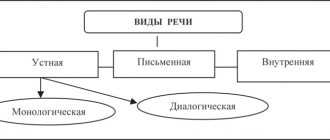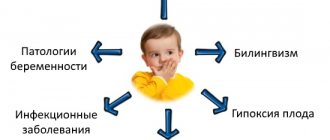I would like to discuss another burning topic - means of developing the speech of preschool children. After all, we all dream that children will immediately learn to explain themselves in sentences, with the right words and with the right endings.
And with the right approach, you can significantly speed up this process!
Basic means of speech development
The importance of speech
Agree, until the first conscious words and statements it is difficult to perceive a screaming lump as a person with his own thoughts and desires, but a talking child is already a worthy interlocutor with whom you can and should talk about literally everything.
The child himself also needs the ability to speak. It helps him communicate with family, friends, and peers in the garden.
Methodological tools
- conversation with adults;
- speech of a kindergarten teacher;
- special classes, for example, with a speech therapist or lessons on early development methods;
- reading fiction;
- art classes.
Communication with family
When the child begins to speak his first words, there is no need to relax, there is still a lot of, but interesting work ahead. We talk to him as often as possible, talking about surrounding objects and actions, calling names, colors, characteristics of things, asking leading questions, playing with him.
Recommendations for home:
- reading poetry, nursery rhymes, tongue twisters, fairy tales;
- sing simple and catchy songs with him, as musical works train breathing, help cope with stuttering, form correct phonemic hearing, and develop a speech rate;
- recite simple poems or riddles with him that involve pronouncing the right word, read the first part to the baby, and let him say the last word, remember, and choose. If the child finds it difficult, you can suggest the first part of the required word;
- watch and read colorful fairy tales with your child, pointing your finger at the mentioned characters and objects as the story progresses; dialogues need to be read in different intonations, you can even copy the voices of animals and people;
- use finger games, it has been proven that these interesting, memorable poems and songs, when combined with certain gestures, not only help develop memory, but also accelerate the development of speech, and playing them is very interesting even for adults, you know, it’s addictive!
Be sure to read about the features of using tongue twisters for children.
Kindergarten teacher's speech
A very important part of the development of coherent speech, because the child hears this person almost every day for several hours and remembers the peculiarities of the construction of words and sentences. It has been proven that children, like sponges, absorb new interesting phrases and expressions, so that they can later use them in conversation.
The most favorable environment for children is the calm, friendly tone of the teacher and his meaningful, understandable and vivid speech.
Special classes
In principle, in early childhood development classes, teachers use all the same methods as caring mothers - the same nursery rhymes, rhymes, songs, riddles, finger games.
Reading fiction
The effectiveness of fairy tales and folklore for a child is difficult to overestimate, because you and I grew up and learned from stories about the pockmarked hen, sleeping beauty, Cinderella, Little Red Riding Hood and many other instructive stories.
The methodology as a science also recognizes the importance of fiction, because through it children first learn to feel the beauty and imagery of their native language, and then they try to recreate individual words and phrases.
In our age of technological progress, modern gadgets with interesting games for kids and exciting cartoons are increasingly coming to the fore, to watch which you do not need to use your imagination and imagine the events described in history. But if possible, we still teach our children to the printed word; even the most fashionable TV cannot replace it.
Art classes
Painting, music, theater are also helpers for the development of a child’s speech; they evoke a strong emotional response, which requires dedication from the child and provokes a desire to share impressions.
Take your little one to a puppet theater or a special children's show, try to become actors yourself by playing with your favorite toys or purchasing a finger theater made from soft toys or paper figurines. Let the child express himself as a creative person, try out different roles, intonations and voices.
The means to quickly develop a child’s speech are multifaceted and varied. Sometimes it’s enough just to pay attention to the baby and have fun playing useful games to notice tangible results. Choose the most suitable game and help your baby quickly master communication skills.
Development of children's speech in different types of activities
The relationship between speech and the content of activity intensifies with age. The need for verbal expression differs in different types of activities.
While playing with his toy, the preschooler conducts a dialogue with it. This one-sided conversation can be internal, not expressed in words. But more often the child says out loud all his calls to his toy friend.
Playing with peers offers other conditions. It is necessary to contact your partner, it is also important to hear him and exchange information. If at younger preschool age verbal communication in the game is simple and may be limited to role-playing participation, then older preschoolers often use explanatory speech.
The speech of a preschooler, which presents a holistic message and fully describes the situation, is called explanatory.
Explanatory speech develops well when preschoolers agree on the rules of the game or coordinated actions and explain the structure of the toy.
The creative activity of a preschooler is also permeated with speech. A child's drawing often needs explanation. And not only due to the fact that the adult asks what is shown on the sheet. More often than not, the author himself wants to tell what he drew. Speech description invariably enriches the content of the picture. Or dots the i's if something incomprehensible is depicted.
With the help of speech, children convey the character of their characters, thus overcoming the limitations of their own artistic abilities.
Child speech development at 2-3 years old
As a rule, at 2-3 years old, even the laziest and most inert child begins to actively develop, learning new words and concepts. Pediatricians note such developmental features as active memorization of new words and their combinations. At this age, kids, like sponges, are able to learn 3-4, or even a dozen new concepts per day, developing by leaps and bounds.
Of course, the speed is different for each child. Some begin to speak in correct sentences, inflecting words literally from the age of two, while others slowly gain a passive vocabulary, memorizing new knowledge, but keeping silent until a certain time.
But at about 2-3 years, speech becomes the main tool for communication, the child tries to convey his opinions and desires to both adults and peers. And this skill needs to be stimulated and developed, helping the baby to develop more actively with the help of exercises and games.
Causes of poor speech in children
- Diseases of the ears and nasopharynx, especially with protracted diseases that deplete the body.
- Lesions of the central nervous system, characterized by mental retardation.
- Lack of attention from relatives.
What will help speed up speech development?
- Fine motor stimulation
It has been proven that in a child’s brain the centers responsible for clear motor skills and speech are located nearby, and stimulation of the first provokes the development of the second. Here, experts recommend using small objects that the baby can sort through; puzzles are an excellent example.
Buy simple cute pictures and collect them together with your child, captivating him with the story that in the end you can get a beautiful picture.
You can also draw with finger paints, felt-tip pens, and pencils, trying not only to train your little one’s hand, but also, during creativity, to call colors, shapes and designs by their proper names in order to increase the baby’s vocabulary.
- Breathing exercises
For correct articulation, the child needs to learn to pronounce words as he exhales, which means he needs to control his speech breathing, the strength of his voice and the muscles of his lips.
Various games are used for these purposes:
“snowflake” - cut out a snowflake from thin paper and invite the child to blow it from the palm of his hand;
“boat” - make a boat out of paper, lower it into a basin of water and invite the child to set the direction of the ship by blowing it off;
“butterfly” cut out a butterfly, and after threading a thread through it, invite the baby to make it fly - to do this, blow on it.
- Articulation gymnastics
It helps improve control of the lip and tongue muscles needed to accurately produce sounds.
The simplest exercises can be a child making antics in front of a mirror while washing his face, ask him to stretch his lips into a tube and pronounce the letter “o” and syllables with it. You can train your baby's tongue by simply smearing your lips with honey, jam or other sweets.
Later you can move on to more complex speech therapy sessions. For example, invite the child to reach his cheeks, nose, chin with his tongue, click it like a horse, and “put it to sleep” on his teeth.
An ordinary smile can be an equally useful game - it helps children master the difficult sound “Y” to pronounce.
- Outdoor games with sound
Little children love noisy, fun games, during which you need to follow the clues contained in the poems; an excellent example of such fun would be “The Sea Is Worried Once”, “Geese-Geese”.
You can learn such rhymes on your own, and then play with your baby, encouraging him to repeat at least the simplest words.
- Conversations with adults
Children cannot learn to talk, always being in splendid isolation; development is only possible with close and interesting communication. You've probably heard that you need to talk to babies literally from birth.
It is especially important to talk with children after two years. And not just limit yourself to monosyllabic answers, but explain in detail, albeit in simple words, everything that interests the baby.
In turn, you need to ask the child his opinion and decisions, stimulating not ordinary answers in the “yes” or “no” format, but real sentences - this is the only way children develop coherent speech.
To do this, you need to learn how to correctly formulate questions, abandoning the usual “do you want to eat?” in favor of “what will you eat?” or say instead of “what is the bear doing?” - “why is he crying, laughing, what is he doing?”
Prices for speech development
| Types of activities | Cost of one lesson/session | Duration of one lesson/session | Recommended number of classes/sessions |
| Diagnostic consultation with a speech therapist | 1000 rub. | 30 min. | 1 lesson |
| Individual speech therapy session | 800/1000 rub. | 45 min. | 10-15 sessions |
| Group speech therapy session | 600 rub. | 45 min. | from 2 times a week |
| Logomassage classic | 800/1000 rub. | 45 min. | individually |
| Logomassage touch | 800/1,000 rub. | 15 minutes. | from 2 times a week |
| Logorhythmics group lesson | 600/800 rub. | 45/60 min | 1 time per week |
Features of speech development in children 3-4 years old
The child's vocabulary increases every month. If at the age of three he speaks 1000 words fluently, then by the age of four his vocabulary increases to 2000. At this age he already knows how to make sentences, ask and answer questions, and speaks coherently. But things don't always go so smoothly.
The development of children 3-4 years old is very individual. Some speak well and coherently, others try to answer in monosyllables or remain silent altogether. At this age, most children cannot yet retell fairy tales or stories, but they can already have a conversation about issues, especially if they are guided. In constructed sentences, they make many mistakes in case endings, the use of pronouns and gender.
Also at this age, children do not pronounce sounds clearly, some replace or throw them out, so they are difficult to understand. Experts believe that this is not yet a problem, since each child has his own characteristics, temperament, inclinations, abilities and genetics. And by the age of five he already speaks clearly and correctly.
Approaches and means to stimulate speech development
The speech development of preschool children at different age stages is more effectively influenced by not the same methods and means. Each age has its own techniques. For example, it would seem that pictures are suitable stimulus material for speech development. However, there is a catch to using them. If you show a plot image to a 3-4 year old preschooler and ask him to tell him what he sees, the child will use more situational speech (“Here is a boy standing”, “The dog ran there”, etc.).
Based on this fact, in no case should pictures be abandoned, but when using them, children of primary preschool age should be encouraged to clarify details and express themselves in detail. Already at the age of 5, preschoolers, using illustrations as a visual support, are able to compose a completely logical and complete story, and the situational nature of their speech is greatly reduced.
Preschoolers aged 6-7 years have a large enough vocabulary to compose a full-fledged story, looking at both a series of pictures and an artistic canvas.
K.D. Ushinsky argued that a painting is a powerful means of “untying” a child’s language: he asks questions about what he sees in the painting, shares his impressions, and describes how the plot of the image seems to him.
Thus, it is important for adults to use approaches and means that are appropriate to the child’s actual development and allow them to take a step forward. Let us present several means and methods that are most suitable for preschool age.
Speech development in the game
The game creates excellent conditions for the development of explanatory speech. Agree on the rules of the game or explain to your partner what his role in the game plot is; to explain the action of a toy or to defend his opinion with reason - in such circumstances, the preschooler will have to go beyond the context, abandon situationally oriented phrases and meaningfully express his thoughts.
We still have to wait until the time when a preschooler will explain himself in a game with his peers. And at 3-4 years old, the role of play partner will have to be played by parents or grandparents.
Many people are familiar with how adults accept an invitation to play and a child’s conditions without specifying anything. Frankly speaking, most often they automatically and formally supposedly participate in the game, while simultaneously going about their business. But even just five minutes of real attention in a game can have an impact on the development of a child’s speech skills. Asking the child what roles should be played, helping him formulate the rules of the game, paying attention to the attributes - all these are ways to get the child talking and, moreover, lay the foundations of communication skills.
Fairy tales and literature as a means of speech development
Fairy tales and children's literary works develop the child's perception and understanding of speech. While listening to a work, a preschooler focuses on a complex plot with several lines, simultaneously keeps in memory and tracks the fate of several characters, immerses himself in the description of events and captures many details. Moreover, the older preschooler independently determines the main idea of the story, the moral of the tale, and evaluates the characters.
Already from the age of three, listening and telling fairy tales, stories, and rhymes perform two important speech functions:
- secreting;
- synthesizing.
The highlighting function when perceiving literary texts (as well as oral narratives that fill our lives) is responsible for ensuring that the child identifies the main points that make up the content of a work or a lengthy reference to it. In simple words, thanks to the highlighting function, the child understands what is being said.
The task of the synthesizing function is to combine individual elements into a single plot or to apply familiar images and speech patterns in a new context.
We can say that the use of literature in raising children has a global impact on their speech development. The child learns to grasp the main thing, receives an example of expressing thoughts, masters ready-made speech patterns, etc.
Where else, if not in literary works, can a child hear so many artistic techniques of speech. The preschooler first uses epithets, comparisons and other means of expression mechanically, retelling the plot. Over time, the means of linguistic expression become firmly established in the child’s vocabulary and are used arbitrarily.
A more detailed discussion of the formation of speech skills with the help of children's works is presented in the article Fairy Tale in the Development of Preschooler Speech.
Elements of theater to help speech development
Everyone knows how much preschoolers love to try on different images. Either they, in the role of a doctor, sternly ask the “patient” about their well-being, then they act as a sorcerer and pronounce magic spells, then they alternately voice each toy, starting a dialogue between them.
That is, all children, to a certain extent, are born artists who easily take on the role and speak on behalf of the hero. This beneficial potential and theatrical activities should be used as a means of speech development.
In a theatrical game, you can either act out ready-made plots, or you can improvise during the action. If this is a favorite fairy tale, then the child already knows many of the characters’ phrases and monologues and repeats them with pleasure.
An adult’s prompts help not to limit oneself only to those phrases that are already familiar to the child, but encourage him to continue speaking on behalf of the character.
To help, the article Development of children's speech through theatrical activities.
It is very useful to memorize short literary texts and poems that are understandable to a preschooler, and then voice them “like an artist.” Correct literary speech allows a child to feel the beauty of his native language, use words to express his speech and enrich his active vocabulary.
Possibilities of logorhythmics in speech development
Accessible and effective means of speech development also include such a modern approach as logorhythmics. However, the only modern thing here is the name. And many years ago, children used a combination of certain actions and rhythmic recitatives in their games. Now a new term has become widespread
Logorhythmics is a technology aimed at the comprehensive development of a child. By pronouncing words and performing certain movements, the baby trains speech skills, articulation and motor skills.
These exercises are fun for children. They easily remember and willingly perform poetry and recitatives, sing songs with various sounds that imitate animals and natural phenomena (meow-meow, drip-drip-drip, etc.), while incorporating movements. An effective technique for speech development in children 3-4 years old.
Logorhythmics is especially useful at the stage of active pronunciation formation and covers an even wider age range - from 2.5 to 4.5 years. By performing exercises, children learn to combine speech and movements, which has a direct impact on the formation of rhythm, tempo and melody of speech. At the same time, speech breathing is trained.
Delayed speech development
The main reason for delayed speech development (SDD) in children is its lack of demand. This is revealed in the lack of communication with peers, lack of communication with parents and others. Typically, RRD is observed in those children who are deprived of children's company and have parents who are constantly busy with themselves.
Another reason for this deviation may be genetics or diseases of the nervous system and brain associated with mental retardation.
The next reason for the appearance of RRD is lack of hearing, complete or partial deafness. A child's speech develops based on the sounds he hears. If these sound streams do not exist, then the child will not speak on his own.
Speech development tasks
The psycho-speech development of a child occurs, first of all, due to the natural processes of maturation of the body and the formation of personality. Everything that a baby unconsciously guides while exploring the world is his needs. Adults understand perfectly well that a child must cover a considerable distance in speech development in just a few years. By the time it is time to go to school, a preschooler needs to:
- Know and use many words
- Speak clearly and coherently
- Using speech, receive various cognitive information
- Communicate with peers and adults
The listed tasks are the most important in the speech development of preschool children. They are resolved gradually at each age stage.
How to talk to a child
For timely development, classes need to be conducted from infancy. You need to talk to your baby slowly, measuredly, clearly pronouncing everything, don’t lisp, don’t distort words, don’t rush him with an answer and be sure to correct him if necessary.
Sometimes it is difficult for a baby to pronounce all sounds correctly, in this case he needs to be supported and encouraged, and in no case should he be scolded or teased.
During classes you should pay attention to breathing, intonation, and strive for complete answers. At the age of 3-4 years, children already know the names of toys, colors, shapes of objects, etc., so you need to communicate with him more and gently force him to pronounce all the emotions and feelings, describe the world around him, talk about his desires and needs.
If necessary, you need to contact a specialist - a speech therapist, he will advise how to approach the classes correctly, what to pay attention to first and, if necessary, he will conduct the classes himself.









